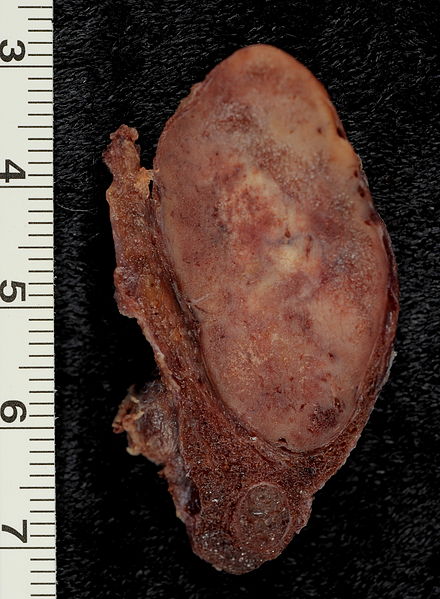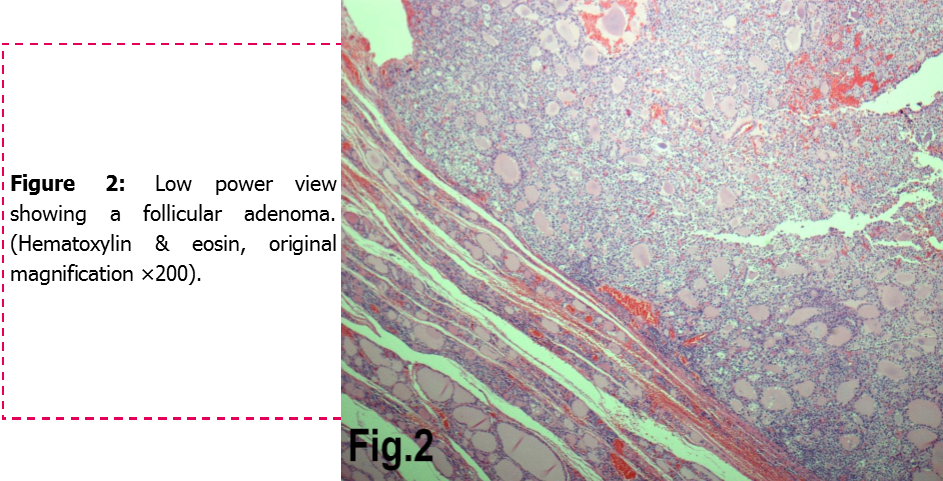Thyroid adenoma pathophysiology: Difference between revisions
No edit summary |
|||
| Line 4: | Line 4: | ||
==Overview== | ==Overview== | ||
==Pathogenesis== | ==Pathogenesis== | ||
A thyroid adenoma may be clinically silent, or it may be a "functional" [[tumor]], producing excessive [[thyroid hormone]]. In this case, it may result in symptomatic [[hyperthyroidism]], and may be referred to as a ''toxic'' thyroid adenoma. Careful [[pathology|pathological]] examination may be necessary to distinguish a thyroid adenoma from a minimally invasive [[thyroid cancer|follicular thyroid carcinoma]]. | Thyroid adenoma are lumps which commonly arise within an otherwise normal [[thyroid|thyroid gland]].<ref name="urlNew York Thyroid Center: Thyroid Nodules">{{cite web |url=http://www.cumc.columbia.edu/dept/thyroid/nodules.html |title=New York Thyroid Center: Thyroid Nodules |work= |accessdate=}}</ref> They indicate a [[thyroid]] neoplasm. | ||
* Sometimes a thyroid nodule presents as a fluid-filled cavity called a thyroid cyst. Often, solid components are mixed with the fluid. Thyroid cysts most commonly result from degenerating [[thyroid adenoma]]s, which are benign, but they occasionally contain malignant solid components.<ref>[http://www.mayoclinic.com/health/thyroid-nodules/DS00491/DSECTION=causes mayoclinic.com > Thyroid nodules] Feb. 22, 2011</ref> | |||
* A thyroid adenoma may be clinically silent, or it may be a "functional" [[tumor]], producing excessive [[thyroid hormone]]. In this case, it may result in symptomatic [[hyperthyroidism]], and may be referred to as a ''toxic'' thyroid adenoma. Careful [[pathology|pathological]] examination may be necessary to distinguish a thyroid adenoma from a minimally invasive [[thyroid cancer|follicular thyroid carcinoma]]. | |||
===Colloid Nodules=== | ===Colloid Nodules=== | ||
Colloid nodules (CN) are non-neoplastic benign nodules occurring within the thyroid gland. They form the vast majority of nodular thyroid disease. Colloid nodules are composed of irregularly enlarged follicles containing abundant colloid. Some colloid nodules can be cystic (cystic colloid nodule), and may contain areas of necrosis, haemorrhage and/or calcification. Colloid nodule may be single or multiple and can vary considerably in size.<ref> Colloid nodule (thyroid). Radiopedia 2015. http://radiopaedia.org/articles/colloid-nodule-thyroid-1 Accessed on October,7, 2015</ref> | Colloid nodules (CN) are non-neoplastic benign nodules occurring within the thyroid gland. They form the vast majority of nodular thyroid disease. Colloid nodules are composed of irregularly enlarged follicles containing abundant colloid. Some colloid nodules can be cystic (cystic colloid nodule), and may contain areas of necrosis, haemorrhage and/or calcification. Colloid nodule may be single or multiple and can vary considerably in size.<ref> Colloid nodule (thyroid). Radiopedia 2015. http://radiopaedia.org/articles/colloid-nodule-thyroid-1 Accessed on October,7, 2015</ref> | ||
Revision as of 05:57, 12 October 2015
|
Thyroid adenoma Microchapters |
|
Diagnosis |
|---|
|
Treatment |
|
Case Studies |
|
Thyroid adenoma pathophysiology On the Web |
|
American Roentgen Ray Society Images of Thyroid adenoma pathophysiology |
|
Risk calculators and risk factors for Thyroid adenoma pathophysiology |
Editor-In-Chief: C. Michael Gibson, M.S., M.D. [3]; Associate Editor(s)-in-Chief: Ammu Susheela, M.D. [4]
Overview
Pathogenesis
Thyroid adenoma are lumps which commonly arise within an otherwise normal thyroid gland.[1] They indicate a thyroid neoplasm.
- Sometimes a thyroid nodule presents as a fluid-filled cavity called a thyroid cyst. Often, solid components are mixed with the fluid. Thyroid cysts most commonly result from degenerating thyroid adenomas, which are benign, but they occasionally contain malignant solid components.[2]
- A thyroid adenoma may be clinically silent, or it may be a "functional" tumor, producing excessive thyroid hormone. In this case, it may result in symptomatic hyperthyroidism, and may be referred to as a toxic thyroid adenoma. Careful pathological examination may be necessary to distinguish a thyroid adenoma from a minimally invasive follicular thyroid carcinoma.
Colloid Nodules
Colloid nodules (CN) are non-neoplastic benign nodules occurring within the thyroid gland. They form the vast majority of nodular thyroid disease. Colloid nodules are composed of irregularly enlarged follicles containing abundant colloid. Some colloid nodules can be cystic (cystic colloid nodule), and may contain areas of necrosis, haemorrhage and/or calcification. Colloid nodule may be single or multiple and can vary considerably in size.[3]
Genetics
Associated Conditions
Gross Pathology
Thyroid follicular adenoma ranges in diameter from 3 cm on an average, but sometimes is larger (up to 10 cm) or smaller. The typical thyroid adenoma is solitary, spherical and encapsulated lesion that is well demarcated from the surrounding parenchyma. The color ranges from gray-white to red-brown, depending upon
- the cellularity of the adenoma
- the colloid content.
-
Follicular Adenoma of the Thyroid Gland
Microscopic Pathology
- Areas of hemorrhage, fibrosis, calcification, and cystic change, similar to what is found in multinodular goiters, are common in thyroid (follicular) adenoma, particularly in larger lesions.
- Encapsulated tumors without evidence of infiltration
-
Follicular adenoma of the thyroid gland
-
Histology of the encapsulated tumor. (a) Photomicrograph showing an encapsulated tumor composed of cells arranged in microfollicular, glandular and trabecular patterns (hematoxylin and eosin; 100×). (b) High power photomicrograph showing the microfollicles containing inspissated colloid resembling hyaline globules and separated by eosinophilic extracellular hyaline material. (hematoxylin and eosin; 100×).[4]
Histopathological Video
Video
{{#ev:youtube|iVANfjos88Q}}
Reference
- ↑ "New York Thyroid Center: Thyroid Nodules".
- ↑ mayoclinic.com > Thyroid nodules Feb. 22, 2011
- ↑ Colloid nodule (thyroid). Radiopedia 2015. http://radiopaedia.org/articles/colloid-nodule-thyroid-1 Accessed on October,7, 2015
- ↑ Image courtesy of Dr Frank Gaillard. [1] (original file[2]).Creative Commons BY-SA-NC

